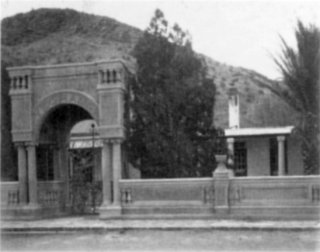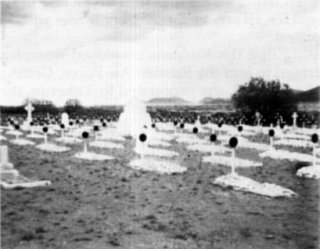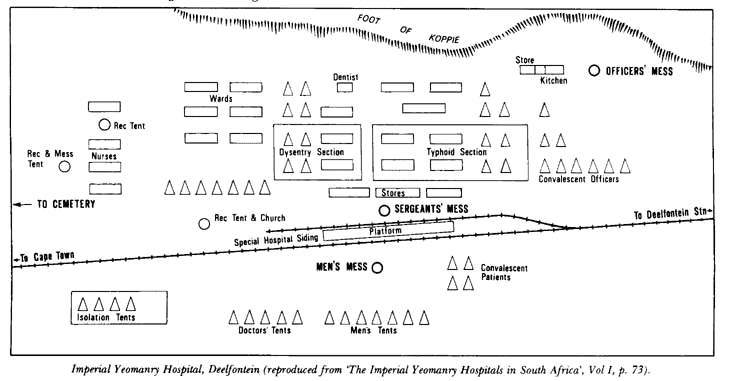

 The South African
The South African
While on leave in November, 1975, I visited a small village named Deelfontein which is approximately 64 km south of De Aar on the main railway line to Cape Town. It was at Deelfontein that the Imperial Yeomanry Hospital was situated during the South African War. The buildings are still in existence and are in a fairly good state of repair.

Yeomanry Officers' Mess,
still called the Yeomanry Hotel
The old Officers' Mess is an hotel (The Yeomanry Hotel). The walls of the lounge and private lounge are covered with rather beautiful murals, obviously painted by members of the Imperial Yeomanry Staff during the period that they were stationed there. In the undergrowth, almost completely covered by shrubs, is an old pillar box. Adjoining this building is a shop (still functioning), owned by Adamstein Bros who opened this business in 1883. One brother is still alive, but lives on a farm. The shop is run by an aged coloured woman who said she was about three years old when the Hospital was in use. She was most interesting.

Main Military Cemetery referred to.
The small cemetery containing five graves
is approximately 100m further north.
Some three quarters of a kilometre away is the cemetery, very well kept, containing about 130 graves, some with marble headstones but most with Iron Crosses. About 90% of those buried there were young soldiers aged 17 to 24 years, who died of enteric and pneumonia. About 100 metres north-west is a small cemetery containing only five graves. Two have marble stones and three, iron crosses. One stone commemorates a Cpl Collings DCM and on the other only the name Mathews is decipherable. Why these five are buried there and not in the main Cemetery is puzzling. Can anyone provide an explanation? I am particularly interested because my late father-in-law, Donald Munro, was a doctor at Deelfontein, with the Imperial Yeomanry and remained in South Africa after the war as a GP at Steynsburg where he died in 1949.
Captain Loraine-Grew's letter in the June issue of the Journal is an interesting one, but contains some errors. Anyone interested in the Imperial Yeomanry Hospitals, or medical practices during the Anglo-Boer War, should consult the 3-volume publication "The Imperial Yeomanry Hospitals in South Africa 1900-1902" (ed. Countess Howe; Publ. Arthur L. Humphreys, London, 1902). Contained within are details as diverse as diet tables and officers' mess wine lists ("Whiskey - Large Bottle - 2/6"); wards equipment and personnel; gifts and drugs received ("Handkerchiefs - 16 953" "Nightingales - 1914"); surgical, medical, opthalmic and X-Ray department reports, and numerous photographs including Roodewal station after the Boer attack.
Apart from Deelfontein, there was an I.Y. hospital in Pretoria and an active field hospital and bearer company; small Yeomanry hospitals at Mackenzie's Farm, Cape Town and Elandsfontein, and an officers' convalescent home at Johannesburg.
It is extremely doubtful that any of the original Deelfontein hospital buildings are still standing. As can be seen from the plan, the hospital complex was some distance from the station (and present shop and hotel), and consisted of tents and huts. The site of these can be located today on the ground (between the new post office and the cemetery) but no buildings remain. The old Yeomanry Hotel formed no part of the complex, the greater part of it (including the section with the hand-painted murals) being built sometime after the war. In 1900 the Medical Officer described Deelfontein as consisting of the station itself, 'a large water tank and pumping plant, pumpman's cottage and garden, and a small store.'
Anyone visiting Deelfontein today might be forgiven for wondering why that particular site was chosen, but it offered a healthy climate (dry atmosphere and altitude of about 1400 m.), sheltered position, a plentiful supply of good water, good drainage, isolation from other towns and villages but with easy rail access, a convenient distance from the front, and locally available fresh foodstuffs.
The hospital staff arrived in March, 1900 under Col. A.T. Sloggett, CMG, R.A.M.C., and remained until 2nd April, 1901, when the hospital was handed over to the military authorities as No.21 General Hospital. During that period 351 officers and 5 742 men were admitted as in-patients, of whom roughly four-fifths were medical cases (including enteric, dysentery, scarlet fever, measles, influenza, mumps, malaria, malta fever, various diseases, rheumatism and general debility).
X-Ray as a surgical tool was still in its infancy and the Deelfontein report of the surgeon-radiographer in charge, Dr. Hall-Edwards L.R.C.P., F.R.P.S. is of particular interest. He was later to have both hands amputated as a result of extensive exposure to X-rays, according to Charles Fry (article in 'The Argus' 3 October 1970) who worked with Hall-Edwards at Deelfontein.
So far no explanation for the separate cemeteries mentioned by Capt Loraine-Grews has been forthcoming, but earlier this year the 5 isolated names were in fact all legible. In the past both cemeteries have been well cared for by the Adamsteins. Unfortunately of the two brothers who were until recently living there one has died and the other intended settling elsewhere. In June 1976 the future of both hotel and shop seemed precarious, and one can only hope that whoever has taken over the Deelfontein Trust will continue to care also for the cemeteries.

Return to Journal Index OR Society's Home page
South African Military History Society / scribe@samilitaryhistory.org